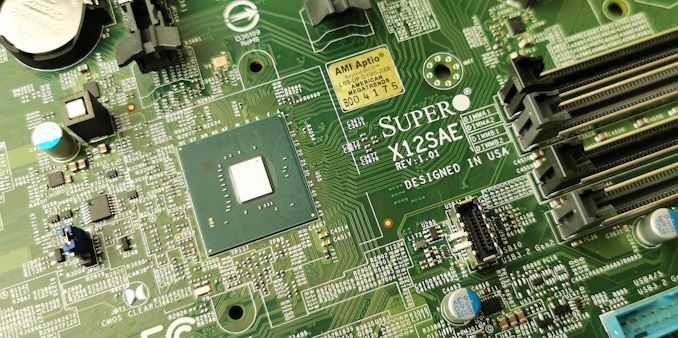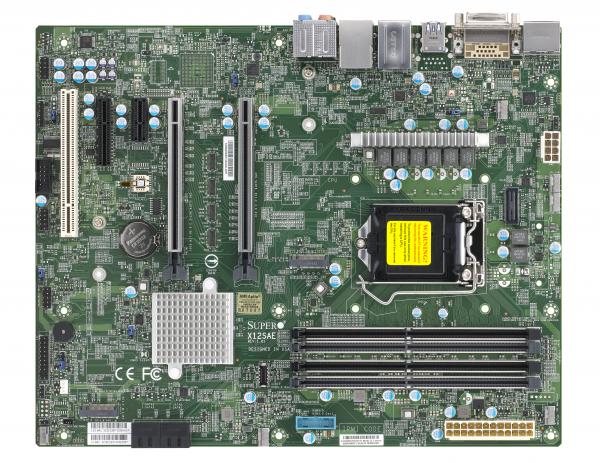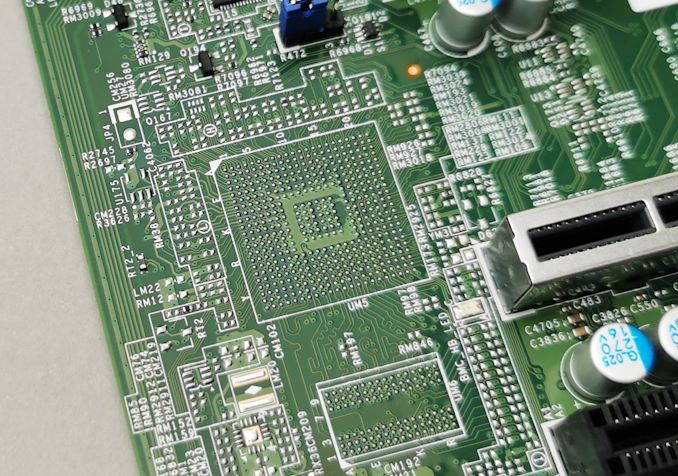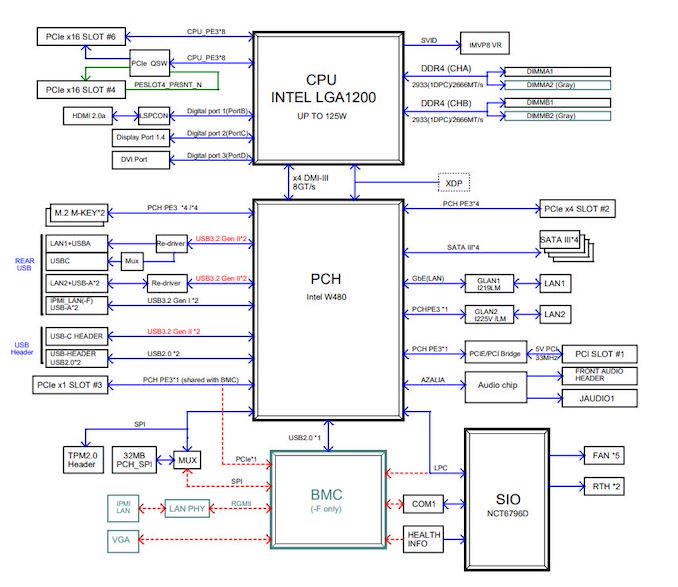Supermicro X12SAE W480 Motherboard Review: For Xeon W-1200 Workstations
by Gavin Bonshor on December 11, 2020 9:30 AM EST
We have seen numerous Intel Z490 motherboards over the months since Intel's platform for Comet Lake was announced back in April. While the Z490 is designed for regular consumers and gamers who intend to use the desktop Intel Core i5/i7/i9 processors, Intel also launched its W480 chipset slightly later which is designed for its workstation orientated Xeon W-1200 series. One such board designed specifically for the Xeon W-1200 processors is the Supermicro X12SAE with support for up to 128 GB of DDR4-2933 of ECC and non-ECC UDIMMs. Also included in the feature set are two PCIe 3.0 x4 M.2 slots, dual Ethernet including a 2.5 Gigabit controller, as well as a dedicated Intel PHY with Intel AMT and vPro support.
Supermicro X12SAE Overview
For every current W480 model on the market, there are at least 4-5 Z490 variants, which makes Intel's workstation platform slim pickings for choice. One of the reasons behind this is down to necessity, with workstations platforms opting for functionality and core feature sets over bling and fancy designs. What the Supermicro X12SAE lacks in visual appeal, it makes up for in its feature set with much of what we have come to expect from its mid-level professional models. The X12SAE is the only conventional ATX sized model from a trio we looked at when we overviewed the W480 chipset earlier on in the year, and as such, has a lot of features included on its green and basic looking PCB. This unit is designed for mass workstation deployment, rather than aesthetics.
Included in the specifications is a pair of PCIe 3.0 x4 M.2 slots, with drives in both M.2 2280/22110 form factors supported. The X12SAE has a total of four SATA ports with support for RAID 0, 1, 5, and 10 RAID arrays, with dual LAN on the rear panel, one 2.5 GbE controller, and the other via an Intel Gigabit PHY. The glaring difference between the LGA1200 Z490 and W480 chipsets supports ECC memory, albeit unbuffed, with the X12SAE allowing for up to 128 GB of DDR4-2933 across four memory slots. For expansion cards, Supermicro includes three full-length PCIe 3.0 slots operating at x16 and x8/x8/+x4, with one PCIe 3.0 x1 and a single 5 V PCI 5 V 32bit slot.
While there is space on the board for a BMC chip, as shown by the pads above, this model does not have it - users should look to the X12SCA-F for a BMC.
On-board audio is quite standard for a board of this caliber as it uses a decent yet aging HD audio codec, with other rear panel connections including a trio of video outputs consisting of an HDMI, DisplayPort, and DVD-D port. There's also USB aplenty, with support for up to five USB 3.2 G2 ports (four rear panel, one internal), with Type-A and Type-C, as well as three USB 3.2 G1, and two USB 2.0.
Supermicro X12SAE Block Diagram
Comparing the Supermicro X12SAE paired with an Intel Xeon W-2170 processor with the rest of the LGA1200 models we've tested so far, albeit, with an Intel Core i7-10700K (closely matched), we saw the expected levels of performance. In our system tests, we saw lower power consumption overall, which can be attributed to a lower TDP and lower threshold for increase power requirements without much of the jazzy bells and whistles of desktop models. We also saw slow POST times, which is a trait generally associated with workstation and server models. DPC performance out of the box was average yet acceptable. In our computation tests, our W-1270 performed as well as expected, despite the power allowance differences compared to the Core i7-10700K. It should be noted that the Intel Xeon range isn't designed for gaming and the high-burst performance of the Core series of Comet Lake processors makes them superior for tasks such as gaming when compared to the Xeon range.
It should be noted that we experienced a number of issues with the X12SAE, including memory support, a dodgy thermal sensor, and intermittent networking dropouts. Details are over the next few pages.
The Current Intel Xeon W-1200 (Comet Lake) Product Stack
The Comet Lake based Intel Xeon W-1200 processors include much of the same technologies as its desktop counterparts, with extra single-core performance through Intel's Thermal Velocity Boost and Turbo Boost Max 3.0. This pushes one core much further than others for a prolonged period of time. In total, there are three main models, including the W-1250, W-1270, and W-1290, each with two or three variations, including the P SKU's, with the P meaning performance.
| Intel Xeon W-1200 Series Processors Comet Lake (LGA 1200/W480) |
|||||||
| AnandTech | Cores | Base Freq (GHz) |
Turbo One Core |
Turbo All Core |
L3 Cache | TDP (W) |
Price ($) |
| W-1290P | 6/12 | 3.7 | 5.3 | 4.9 | 20 MB | 125 | $539 |
| W-1290 | 6/12 | 3.2 | 5.2 | 4.7 | 20 MB | 80 | $494 |
| W-1290T | 4/8 | 1.9 | 4.7 | 3.8 | 20 MB | 35 | $494 |
| W-1270P | 6/12 | 3.8 | 5.1 | 4.7 | 16 MB | 125 | $428 |
| W-1270 | 4/8 | 3.4 | 5.0 | 4.7 | 16 MB | 80 | $362 |
| W-1250P | 6/12 | 4.1 | 4.8 | 4.5 | 12 MB | 125 | $311 |
| W-1250 | 6/12 | 3.3 | 4.7 | 4.4 | 12 MB | 80 | $255 |
The standard variants include an 80 W TDP, with the P models matching the desktop models at 125 W, with a single T model, the W-1290T with a much lower TDP of 35 W. All of these SKUs include integrated graphics, with support for dual-channel ECC memory, and added security built-in via Intel Hardware Shield.
Putting the WORK into Workstation
Rounding back to the Supermicro X12SAE, it should cost around the $280 mark dependant on the retailer, although Newegg, via a third-party seller, has it listed for $350 at present. Currently, there's not a great deal of competition within the W480 boards on the market, but the GIGABYTE W480 Vision W ($260) is a nice price but resembles a more consumer-focused desktop design and feature set. It certainly doesn't offer the flexibility of remote access and real-time monitoring as the Supermicro. It instead goes for upgraded audio, more SATA. It is a desktop board posing as a workstation board instead of focusing on the professional elements associated with a platform such as W480.
Read on for our extended analysis.













55 Comments
View All Comments
SSNSeawolf - Friday, December 11, 2020 - link
RoCE/iWARP link is a good example. Even a small software-defined storage setup will easily saturate a pair of 50GbE links. 100/200/400 GbE needs PCIe 4 as a practical requirement.ae00711 - Saturday, December 12, 2020 - link
do be serious - that kind of kit isn't installed in single socket /workstations/. That end of the spectrum is for dual (or more) socket.SSNSeawolf - Saturday, December 12, 2020 - link
That's a common use case for this stuff. RDMA cards are $300-400. I'm not sure why you think RDMA is so fancy to need dual or quad socket. Run it on an i5 for all it cares.Jorgp2 - Sunday, December 13, 2020 - link
The fuck would you stick a 400GbE card in this board?Slash3 - Friday, December 11, 2020 - link
The networking issue may be a result of a faulty 1V/V2 revision i225-V LAN controller chip. When plugged into a switch or router at 2.5Gbit, they have a malformed Inter-Packet Gap that can cause dropout, heavily reduced bandwidth or atrocious latency. It was covered briefly at the time and has since fallen a bit by the wayside, but wouldn't surprise me if it was the root cause.https://www.techpowerup.com/img/immgrcH3WvH9P6o0.j...
Mitigation includes an updated driver or to set it manually to 1Gbit.
As for the atrocious memory support and other problems, those are all on Supermicro.
ae00711 - Saturday, December 12, 2020 - link
agreed.the one time I needed support from supermicro, un-f88king-believable - worst I've seen from a tech company. I do have a lot of SM mobos (workstation and server), the products are decent for the most part, but you're f88ked if you need support. I try to buy intel and tyan now-a-days.
RU482 - Friday, December 11, 2020 - link
With regard to ECC memory...if I have this X12SAE motherboard with a Xeon W-1290E CPU, do I HAVE to use ECC UDIMMS? or will the system operate with more common non-ECC UDIMMS?this would ignore the "Why don't you just use a core i9 instead of W-1290E" question
Alsw - Friday, December 11, 2020 - link
Those core counts in the table on page 1 are way off for the most part some copy and paste errors e.g. 1290p is 10 cores, 20 threads. Regarding Intel vs AMD Right now it's tricky in the Workststion space companies want the backup of OEM support only lenovo has broken and started offering threadripper Pro which to be honest isn't that compelling. At the low end most are OK without ECC ram so rysen 5000 would do well against i7/i9 workstations from dell/hp lenovo but as soon as you get to things like FEA, CFD other scientific type workloads then ECC is what users are looking for and not all of them need masses of cores it depends on the solver, problem type etc how well it scalesBut A small change from AMD in properly supporting ECC would make a big difference to making inroads
Maybe they are just less focused on this market as their Radeon pro cards fall ever behind NVIDIA Quadro (I refuse to stop using that name as its just crasy to drop such a string brand!)
DracoDan - Friday, December 11, 2020 - link
Wait... a *PCI* slot?! Like from 1992??? Where did they even find the old-new stock of PCI connectors? Crazy to think that a board that worked in a 486 (albeit a limited subset of 486 systems) can work in this board!Ithaqua - Friday, December 11, 2020 - link
There are a few MB makers that still have PCI / PCI-X / AGP Slots.Not sure about VLBus or ISA (8/16) but who needs to install the original soundblaster card or a CGA video card in a new system?